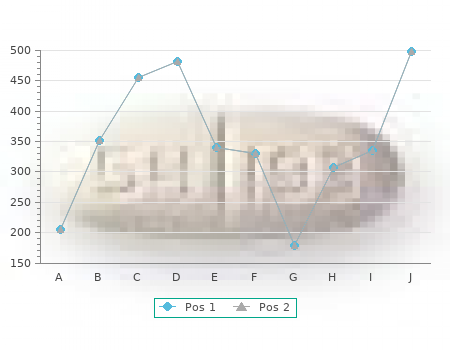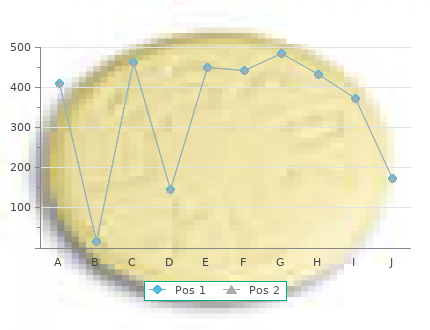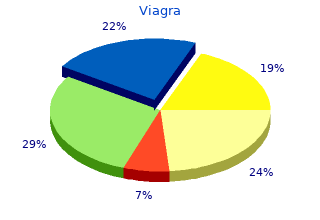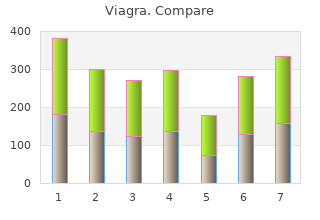Viagra
By H. Bufford. Nichols College.
After 10 days purchase viagra 75mg mastercard causes to erectile dysfunction, the wound weeks after this viagra 50 mg with amex causes of erectile dysfunction in 60s, he was seen in the outpatient clinic with had less purulent material and was getting drier, so the the wound completely healed. The antibiotic was de- dressings were changed to saline-soaked packing. After 2 creased to once a day, and his mother was informed that more weeks, then 3. Radiographs was developing excellent granulation tissue and the pack- showed good healing and formation of fusion mass 4 ing was discontinued in favor of a loose wet-to-dry cover months after the original fusion. After 3 to 4 weeks healthy granulation tissue Figure C9. Spine 495 wound is very large, another return to the operating room for dressing change and debridement under general anesthesia may be required. The debridement may continue on the ward as the necrotic tissue separates and is then re- moved. After all the necrotic tissue has been removed, the wound is allowed to close by secondary intention from the bottom up. The packing should be very loose with a saline-soaked sponge; however, it should be clear that the granulation tissue closes over the rod and that it does not close leaving a fluid-filled cavity as the skin closes over the top. Managing this closure re- quires that physicians continue to check the wound every day or two. This need for frequent wound checks and intravenous antibiotics means that these patients are kept in the hospital for 4 to 5 weeks of treatment until granu- lation tissue has covered the rod, which is the criteria for discharge to out- patient and home nursing care. Typically, intravenous antibiotics specific to the results of the culture are continued at full doses for 6 weeks. After 6 weeks, children are kept on antibiotic suppression therapy with one antibiotic orally if a simple antibiotic is available against the specific organism. This sup- pression therapy is continued for 6 to 12 months. Except for one patient with a very severe infection of the whole spine combined with meningitis, all our other deep wound infections have cleared and the hardware has remained covered and in place without evidence of any late infections. We have had two late deep wound infec- tions occurring 2 and 5 years after the original surgery. One of these was directly related to a concurrent urinary tract infection; however, the other was a staphylococcus infection that was not directly related to any known concurrent problem. Both these infections involved the whole spinal rod and required removal of the rod and all wires. Both wounds healed, and one child has done well for 6 years ex- cept the fusion mass has bent, so he now has an additional 20° of scoliosis (Case 9. The other boy healed his wound well and had almost closed the deep wound when he had a sudden period of shortness of breath followed by a cardiac arrest at home. We have never seen a case of late sterile drainage requiring removal of the hardware, which has been reported with other systems. Usually, there should be a very specific goal to be accomplished, such as getting children into better sitting positions, treating painful nonunions, or improving respi- ratory function. Based on a well-defined problem, a careful plan to achieve these specific goals should be outlined. Using this proximal end avoids having to remove all the old instrumentation and provides a source for rigid proximal fixation. The apex of the curve must be identified, and 496 Cerebral Palsy Management Case 9. With dressing changes and plegic CP was 5 years after a successful posterior spinal antibiotic, the infection cleared. No pseudarthrosis was fusion with Unit rod instrumentation when he presented present when the hardware was removed. He was noted to have mild 18 months after rod removal, the scoliosis curve had erythema along his spine, which was aspirated and grew increased 20° and he had a noticeable increase in his Proteus. The same bacteria also cultured out from his physical position (Figure C9. This increased scolio- urine, so this was believed to be a hematogenous infection sis was thought to be caused by bending of the fusion from his urinary tract.

When the carbons of the amino acids are con- verted to glucose by the liver buy generic viagra 25 mg on-line erectile dysfunction patient.co.uk doctor, their nitrogen is converted to urea proven viagra 50 mg impotence yoga. When we fast for 3 or more days, we are in the starved state. Mus- cle continues to burn fatty acids but decreases its use of ketone bodies. As a result, the concentration of ketone bodies rises in the blood to a level at which the brain begins to oxidize them for energy. The brain then needs less glucose, so the liver decreases its rate of gluconeogenesis. Consequently, less protein in muscle and other tissues is degraded to supply amino acids for gluconeogenesis, Protein Degrees of protein–energy malnu- sparing preserves vital functions for as long as possible. Because of these changes trition (marasmus) are classified in the fuel utilization patterns of various tissues, humans can survive for extended according to BMI. At his height of 71 inches, his body Percy Veere had been admitted to the hospital with a diagnosis of mental weight would have to be above 132 lb to achieve a BMI greater than 18. Ann depression associated with malnutrition (see Chap. At 66 admission, his body weight of 125 lb gave him a body mass index (BMI) inches, she needs a body weight greater of 17. His serum albumin was 10% below the low end than 114 lb to achieve a BMI of 18. Veere’s degree of malnutrition and his progress toward recovery. His arm circumference and triceps skinfold were measured, and his mid upper arm muscle circumference was calculated (see Chap. His serum transferrin, as well as his serum albu- min, were measured. Fasting blood glucose and serum ketone body concentration were determined on blood samples drawn the next day before breakfast. A 24-hour urine specimen was collected to determine ketone body excretion and creatinine excretion for calculation of the creatinine–height index, a measure of protein deple- tion from skeletal muscle. Ann O’Rexia was receiving psychological counseling for anorexia ner- vosa, but with little success (see Chap. She saw her gynecologist because she had not had a menstrual period for 5 months. The physician recognized that Ann’s body weight of 85 lb was now less than 65% of her ideal weight. The admission diag- nosis was severe malnutrition secondary to anorexia nervosa. Clinical findings included decreased body core temperature, blood pressure, and pulse (adaptive responses to malnutrition). Her physician ordered measurements of blood glucose and ketone body levels and made a spot check for ketone bodies in the urine as well as ordering tests to assess the functioning of her heart and kidneys. THE FASTING STATE Blood glucose levels peak approximately 1 hour after eating and then decrease as tissues oxidize glucose or convert it to storage forms of fuel. By 2 hours after a meal, the level returns to the fasting range (between 80 and 100 mg/dL). This decrease in blood glucose causes the pancreas to decrease its secretion of insulin, and the serum insulin level decreases. The liver responds to this hormonal signal by starting to degrade its glycogen stores and release glucose into the blood. If we eat another meal within a few hours, we return to the fed state. However, if we continue to fast for a 12-hour period, we enter the basal state (also known as the postabsorptive state).
Each may occur alone cheap 50mg viagra with visa erectile dysfunction pain medication, or they may be present in any combi- expected from the caloric intake cheap viagra 75mg without prescription erectile dysfunction due to diabetes. Alcohol-induced cirrhosis is discovered in up to 9% of all partly attributable to induction of MEOS, autopsies performed in the United States, with a peak incidence in patients 40 to 55 resulting in a proportionately greater metab- years of age. In general, weight loss diets recom- ing to a fatty liver. It also can result in ketoacidosis or lactic acidosis and cause mend no, or low, alcohol consumption hypoglycemia or hyperglycemia, depending on the dietary state. These effects are because ethanol calories are “empty” in the considered reversible. Diffuse damage to hepatocytes results in cirrho- sis, characterized by fibrosis (scarring), disturbance of the normal architecture and blood flow, loss of liver function and, ultimately, hepatic failure. Acute Effects of Ethanol Arising from the Increased NADH /NAD Ratio Many of the acute effects of ethanol ingestion arise from the increased NADH/NAD ratio in the liver (Fig. At lower levels of ethanol intake, the rate of ethanol oxidation is regulated by the supply of ethanol (usually determined by how much ethanol we consume) and the rate at which NADH is reoxidized in the electron transport chain. NADH is not a very effective product inhibitor of ADH or ALDH, and there is no other feedback regulation by ATP, ADP, or AMP. As a con- sequence, NADH generated in the cytosol and mitochondria tends to accumulate, increasing the NADH/NAD ratio to high levels (see Fig. The increase is even greater as the mitochondria become damaged from acetaldehyde or free radical injury. CHANGES IN FATTY ACID METABOLISM The high NADH/NAD ratio generated from ethanol oxidation inhibits the oxida- tion of fatty acids, which accumulate in the liver (see Fig. The increased NADH/NAD ratio increases the availability of glycerol 3-P by promoting its synthesis from intermediates of glycolysis. The triacylglycerols are incorporated into VLDL (very-low-density lipoproteins), which accumulate in the liver and enter the blood, resulting in an ethanol-induced hyperlipidemia. The hyperlipidemia is greatly Although just a few drinks may result in hepatic fat accumulation, chronic con- enhanced if fat is ingested with sumption of alcohol greatly enhances the development of a fatty liver. Thus, “happy hour” foods cation of fatty acids into triacylglycerols by fatty acyl CoA transferases in the ER is (e. Because the transferases are microsomal enzymes, they cream, nachos, and deep-fried peppers are induced by ethanol consumption just as MEOS is induced. The result is a fatty stuffed with cream cheese and wrapped in bacon) are exactly the wrong things to eat liver (hepatic steatosis). Steamed vegetables or sal- The source of the fatty acids can be dietary fat, fatty acids synthesized in the ads with your beer would be much better for liver, or fatty acids released from adipose tissue stores. CHAPTER 25 / METABOLISM OF ETHANOL 465 NADPH 9 Interference, inhibition Ethanol MEOS of drug metabolism 1 ADH Acetyldehyde (toxin) NADH ALDH NADH Acetate Acetate (blood) + e TCA Malate H + t cycle H c 4 NADH Oxaloacetate 5 Glucose Acetyl CoA Ketone Ketoacidosis NADH bodies Gluconeogenesis Glycolysis β-oxidation FAD (2H) 2 NADH Acetyl CoA DHAP + NAD Pyruvate Glycerol 3 Fatty acyl CoA Fatty acids NADH 3-phosphate NAD+ 6 8 ER Lactate Alanine and Glycerol Triacylglycerols other gluconeogenic Fatty precursors steatosis Purines VLDL 7 Lactate Hypoglycemia Hyperlipidemia Uric acid acidemia – Gout Urine Fig. Acute effects of ethanol metabolism on lipid metabolism in the liver. Glycerol 3-P levels are increased because a high NADH/NAD ratio favors its formation from dihydroxyacetone phosphate (an intermediate of glycolysis). Ethanol-stimulated increases of endoplasmic reticulum enzymes also favors triacylglycerol formation. Thus, acetyl CoA oxidation in the TCA cycle is inhibited. Fatty acids that are oxidized are converted to acetyl CoA and subsequently to ketone bodies (acetoacetate and -hydroxybutyrate). Enough NADH is generated from Al Martini’s admitting physician oxidation of ethanol and fatty acids that there is no need to oxidize acetyl CoA in suspected an alcohol-induced ketoacidosis superimposed on a the TCA cycle. The very high NADH/NAD ratio shifts all of the oxaloacetate in starvation ketoacidosis. Tests showed that the TCA cycle to malate, leaving the oxaloacetate levels too low for citrate synthase his plasma free fatty acid level was elevated, to synhesize citrate (see Fig. The acetyl CoA enters the pathway for and his plasma -hydroxybutyrate level was ketone body synthesis instead of the TCA cycle. The Although ketone bodies are being produced at a high rate, their metabolism in increased NADH/NAD ratio from ethanol other tissues is restricted by the supply of acetate, which is the preferred fuel.

In all natural processes best viagra 25 mg erectile dysfunction treatment in sri lanka, the total entropy of a system always increases viagra 100mg on-line impotence zinc. Constants Units of G and H cal/mole or J/mole: 1 cal 4. A General Expression for G The G0 for the reverse reaction is 1. The change in free energy is the same for the forward To generalize the expression for G, consider a reaction in which aA bB ←→ cC dD and reverse directions, but has an opposite The small letters denote a moles of A will combine with b moles of B to produce c moles of sign. Because negative G0 values indicate C and d moles of D. From initial concentrations of 1 M, OH H OH HO the ATP concentration will decrease, and ADP and Pi will increase until equilibrium is reached. For a reaction in which a substrate S is converted to a product P, the ratio of Glucose-6-phosphate (G6P) the product concentration to the substrate concentration at equilibrium is given by: PGM HOCH2 Equation 1: O G0 RTIn [P]/[S] H H H O OH H O P O– (see Table 19. Glucose 1-phosphate (G1P) Thus, the difference in chemical bond energies of the substrate and product ( G0 ) determines the concentration of each at equilibrium. Endergonic, or endothermic, reactions have a positive G0 for the forward direction (the direction shown), and the backward Fig. For example, in the pathway of glycogen synthesis, phospho- The forward direction is involved in converting glucomutase converts glucose-6-P to glucose-1-P. Glucose-1-P has a higher phos- glucose to glycogen, and the reverse direction phate bond energy than glucose-6-P because the phosphate is on the aldehyde car- in converting glycogen to glucose 6-P. The G0 for the forward direction (glucose-1-P S glucose-6-P) is, therefore, positive. Beginning at equimolar concentrations of both compounds, The G0 for the conversion of glu- there is a net conversion of glucose-1-P back to glucose-6-P and, at equilibrium, the cose 6-P to glucose 1-P is 1. What is the ratio of [glu- determined by G0 for the reaction. It is often said that a reaction with a negative G proceeds spontaneously in the forward direction, meaning that products accumulate at the expense of reactants. However, G is not an indicator of the velocity of the reaction, or the rate at which equilibrium can be reached. In the cell, the velocity of the reaction depends on the efficiency and amount of enzyme available to catalyze the reaction (see Chapter 9), and, therefore, “spontaneously” in this context can be misleading. ENERGY TRANSFORMATIONS TO DO MECHANICAL AND TRANSPORT WORK To do work in the cell, a mechanism must be available for converting the chemical bond energy of ATP into another form, such as an Na gradient across a membrane. These energy transformations usually involve intermediate steps in which ATP is bound to a protein, and cleavage of the bound ATP results in a conformational change of the protein. Muscle fiber is made of thick filaments composed of bundles of the protein myosin, and thin filaments composed of the protein actin (which is activated by Ca2 binding). At many positions along the actin filament, a terminal domain of a myosin molecule, referred to as the “head,” binds to a specific site on the actin. The myosin head has an ATP binding site and is an ATPase; it can hydrolyze ATP to ADP and Pi. This change of conformation at multiple association points between actin and myosin slides the actin filament forward (5). For this reaction, Keq In mechanical work, the high-energy phosphate bond of ATP is converted into [glucose-1-phosphate]/[glucose-6- 3 movement by changing the conformation of a protein (Fig. Substituting in equa- changes the conformation of myosin so that it is in a “cocked” position ready to tion 1 then gives 1. Thus, exercising muscle fibers have almost P]/[glucose-6-P]. Thus, ln[glucose 1-P]/[glu- a hundred-fold higher rate of ATP utilization and caloric requirements than resting cose 6-P] 2. Motor proteins, such as kinesins that transport chemicals along [glucose-6-phosphate] e 2. So fibers, provide another example of mechanical work in a cell. Transport Work In transport work, called active transport, the high-energy phosphate bond of ATP is Otto Shape has not followed his used to transport compounds against a concentration gradient (see Chapter10, proposed diet and exercise regi- men and has been gaining weight. The equations for calculating G are based on the first law of thermodynamics He has a positive caloric balance, because (see Table 19. The change in chemical bond energy that occurs during a reac- his daily energy expenditure is less than his tion is H, the change in enthalpy of the reaction.

It occurs most frequently at the onset of exercise–before vasodilation occurs to bring in blood-borne fuels generic viagra 25mg visa erectile dysfunction at age of 20. The regulation of skeletal muscle glycogen degradation therefore must respond very rapidly to the need for ATP discount 25mg viagra with amex erectile dysfunction vitamin d, indicated by the increase in AMP. The regulation of skeletal muscle glycogen synthesis and degradation differs from that in liver in several important respects: (a) glucagon has no effect on mus- cle, and thus glycogen levels in muscle do not vary with the fasting/feeding state; (b) AMP is an allosteric activator of the muscle isozyme of glycogen phosphory- lase, but not liver glycogen phosphorylase (Fig. However, the effects of epinephrine-stimulated phosphorylation by pro- tein kinase A on skeletal muscle glycogen degradation and glycogen synthesis are similar to those occurring in liver (see Fig. Muscle glycogen phosphorylase is a genetically distinct isoenzyme of liver glyco- gen phosphorylase and contains an amino acid sequence that has a purine nucleotide Epinephrine Nerve impulse Sarcoplasmic cAMP Ca2+ 3 reticulum 2 Ca2+ protein kinase A + ATP myosin 2+ ATPase Ca –calmodulin ADP phosphorylase adenylate kinase P Muscle kinase contraction AMP + 1 + P glycogen glycogen phosphorylase b phosphorylase a Pi Fig. Activation of muscle glycogen phosphorylase during exercise. Glycogenolysis in skeletal muscle is initiated by muscle contraction, neural impulses, and epinephrine. AMP produced from the degradation of ATP during muscular contraction allosterically activates glycogen phosphorylase b. The neural impulses that initiate contraction release Ca2 from the sarcoplasmic reticulum. The Ca2 binds to calmodulin, which is a modifier protein that activates phosphorylase kinase. Phosphorylase kinase is also activated through phospho- rylation by protein kinase A. The formation of cAMP and the resultant activation of protein kinase A are initiated by the binding of epinephrine to plasma membrane receptors. When AMP binds to this site, it changes the conformation at the cat- alytic site to a structure very similar to that in the phosphorylated enzyme (see Fig. Thus, hydrolysis of ATP to ADP and the consequent increase of AMP gen- erated by adenylate kinase during muscular contraction can directly stimulate glycogenolysis to provide fuel for the glycolytic pathway. AMP also stimulates gly- colysis by activating phosphofructokinase-1, so this one effector activates both glycogenolysis and glycolysis. The activation of the calcium/calmodulin subunit of phosphorylase kinase by the Ca2 released from the sarcoplasmic reticulum during muscle contraction also provides a direct and rapid means of stimulating glycogen degradation. CLINICAL COMMENTS Getta Carbo’s hypoglycemia illustrates the importance of glycogen stores in the neonate. At birth, the fetus must make two major adjustments in the way fuels are used: it must adapt to using a greater variety of fuels than were available in utero, and it must adjust to intermittent feeding. In utero, the fetus receives a relatively constant supply of glucose from the maternal circulation through the placenta, producing a level of glucose in the fetus that approximates 75% of maternal blood levels. With regard to the hormonal regulation of fuel uti- lization in utero, fetal tissues function in an environment dominated by insulin, which promotes growth. During the last 10 weeks of gestation, this hormonal milieu leads to glycogen formation and storage. At birth, the infant’s diet changes to one containing greater amounts of fat and lactose (galactose and glucose in equal ratio), presented at intervals rather than in a constant fashion. At the same time, the neonate’s need for glucose will be relatively larger than that of the adult because the newborn’s ratio of brain to liver weight is greater. Thus, the infant has even greater difficulty in maintaining glucose homeostasis than the adult. At the moment that the umbilical cord is clamped, the normal neonate is faced with a metabolic problem: the high insulin levels of late fetal existence must be quickly reversed to prevent hypoglycemia. This reversal is accomplished through the secretion of the counterregulatory hormones epinephrine and glucagon. Glucagon release is triggered by the normal decline of blood glucose after birth. The neural response that stimulates the release of both glucagon and epinephrine is activated by the anoxia, cord clamping, and tactile stimulation that are part of a normal delivery.

Viagra
9 of 10 - Review by H. Bufford
Votes: 347 votes
Total customer reviews: 347 |



